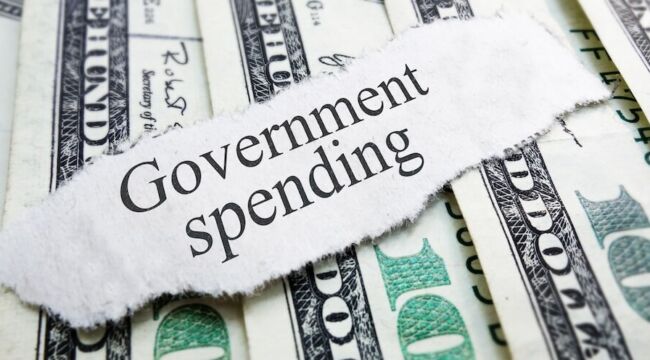The Scourge of Fiscal Dominance
Thomas Jefferson would’ve pooped his pants if he saw what Congress is doing right now. There should be no such thing as fiscal dominance; fiscal policy should be frugal. Spend enough to keep the lights on and let the people drive the economy.
Jefferson would’ve hated our Hamiltonian central bank as well, rap musicals be damned.
But over the past few years, we’ve learned that printing money didn’t cause consumer price inflation (in our everyday definition of inflation).
What caused consumer price inflation was reckless fiscal spending, much to the chagrin of many economists of the Austrian school. I include myself in this group.
Consumer price inflation following money printing and unchecked credit expansion (the Misesian definition of inflation) has been seen throughout history. But that didn’t happen this time.
It didn’t happen because that credit expansion never reached the people. It stayed in the banks.
However, thanks to reckless fiscal policy, the stimulus checks went straight into people’s pockets, and Biden’s social spending further blew out the deficit.
Let’s take the time today to understand the difference between monetary and fiscal policy and why money printing in the 2010s didn’t set off consumer price inflation.
What is Fiscal Dominance?
Fiscal dominance occurs when a government’s fiscal policy (taxing and spending) precedes monetary policy (control of money supply and interest rates). In essence, the central bank becomes subordinate to the government’s fiscal needs. This creates substantial inflation for several reasons:
When the government increases spending significantly without a corresponding increase in tax revenue, it leads to large budget deficits. To cover these deficits, the government may rely on the central bank to print more money (known as “monetizing the debt”). If not matched by an increase in goods and services, this increase in the money supply leads to inflation.
Speaking of fiscal dominance… I had a rousing discussion with my colleague, Jim Rickards, on this topic at our Whisky Bar discussion last night.
We also talked about where America is failing right now… and our hopes for America’s future.
You can check out the replay of our Whisky Bar by clicking here.
Mechanisms: From Congress to the People
Let’s look at how fiscal policy passes money from Congress straight to the people:
- Legislation: Congress passes spending bills, deciding where and how much money should be spent. This could include infrastructure projects, social programs, or direct stimulus payments.
- Treasury Issuance: To fund these expenditures, the Treasury issues debt through bonds.
- Central Bank Purchases: The central bank (e.g., the Federal Reserve in the US) buys these bonds, injecting money into the economy. This is done through open market operations.
- Distribution of Funds:
- A. Government Programs: Funds flow through various federal and state programs, such as Social Security, unemployment benefits, and healthcare.
- B. Direct Transfers: Direct payments (e.g., stimulus checks) are sent to individuals and businesses.
- Bank Deposits: The funds eventually land in bank accounts, increasing the money supply and liquidity in the financial system.
- Spending and Investment: Individuals and businesses spend or invest this money, boosting demand for goods and services.
As a result, we had an inflation rate not seen since the 1970s. The Fed then hiked rates to quell the higher prices, but the inflation story isn’t over yet.
Now, let’s examine why the Fed’s printing money didn’t create higher consumer prices.
Limited Consumer Price Inflation in the 2010s
The Fed’s QE programs involved buying large amounts of financial assets, which increased bank reserves. However, banks didn’t significantly increase lending due to stricter lending standards and a lack of creditworthy borrowers.
The velocity of money (how quickly money circulates in the economy) remained low. High bank reserves didn’t translate into proportional increases in consumer spending.
The increased money supply largely stayed within the financial system, boosting asset prices (stocks, real estate) rather than consumer goods and services.
Globalization and technological advancements kept production costs and consumer prices low. Cheap imports from countries with lower labor costs helped keep inflation in check.
The period saw relatively high unemployment and underemployment rates that limited wage growth. Without significant wage increases, consumer spending power remained constrained.
Long-term inflation expectations remained anchored due to credible Fed policies and the aftermath of the financial crisis. This anchoring effect prevented a significant rise in consumer prices despite increased money supply.
While fiscal dominance leads to high inflation through increased government spending and money printing, the Fed’s expansionary monetary policy from 2009 to 2020 failed to generate significant consumer price inflation because of low bank lending, global economic conditions, and anchored inflation expectations.
So what happened to all that money?
Banks primarily held onto the excess reserves created by the Federal Reserve’s quantitative easing (QE) programs rather than lending them out. Here’s a detailed breakdown of what banks did with these excess reserves:
Holding Reserves at the Federal Reserve
The Fed began paying interest on excess reserves (IOER) in 2008. This incentivized banks to hold their excess reserves at the Fed rather than lending them out. The IOER provided a risk-free return, making it an attractive option for banks.
This may be the dumbest Fed policy ever.
IOER is now the Interest Rate on Reserve Balances (IORB), which is 5.40%. Yes, the Fed prints money and gives it to the banks. The banks then give it back to the Fed and earn interest on it. Asinine.
Lending and Investment
In the aftermath of the 2008 financial crisis, banks became more risk-averse, tightening their lending standards. They feared defaults and were more cautious about extending credit to individuals and businesses.
During the recovery period, demand for loans was relatively weak. Businesses and consumers were deleveraging and were more focused on paying down existing debt rather than taking on new loans.
Instead, banks invested in low-risk government securities (such as Treasury bonds). These assets were considered safe and provided a stable return. Some banks also invested in high-quality corporate bonds, seeking higher returns while managing risk.
Impact on the Economy
Banks used excess reserves to bolster their liquidity positions. This was partly in response to new regulatory requirements (e.g., Basel III) that mandated higher liquidity and capital standards to ensure financial stability.
The presence of substantial excess reserves, along with low interest rates, contributed to a search for yield, also called “chasing yield.” It led to increased investment in financial markets, inflating asset prices such as stocks and real estate, rather than translating into higher consumer price inflation.
Why Excess Reserves Did Not Lead to Significant Inflation
The money multiplier effect (whereby initial bank reserves lead to multiple rounds of lending and deposit creation) was weaker. Since banks held onto the reserves rather than lending them out, the potential for money creation was limited.
Ongoing economic uncertainties and the slow recovery after 2008 meant consumers and businesses were hesitant to borrow and spend, reducing the impact of excess reserves on the broader economy.
Due to factors like technological advancements and globalization, low inflationary pressures globally kept consumer price inflation in check despite the increase in reserves.
Wrap Up
Banks largely kept excess reserves at the Fed, earning a risk-free return through IOER. They were cautious in their lending practices, invested in low-risk assets, and bolstered their liquidity positions to comply with regulatory requirements.
These actions resulted in limited money creation and lending, contributing to the subdued inflation observed from 2009 to 2020 despite the expansionary monetary policy.
But now, the USG opens the fiscal spigot, and the people drink deeply. That’s why consumer price inflation was unleashed in 2021 and will continue to be a problem in the coming years.
Ensure you invest in assets that’ll rise with inflation, such as some stock market sectors, commodities, crypto, and real estate.



Comments: